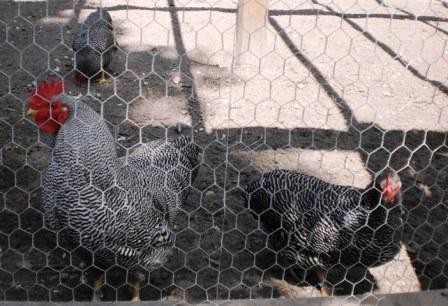The chicken (Gallus gallus domesticus) is the most common fowl. There are many varieties and types. Some we love for meat, another for the eggs.
In a group (flock, clutch) rules a strict hierarchy, the peck(ing) order. Which also determines who may eat when.
Chickens can be up to 10, some even 20 years old. I prefer a young chick over a tough soup chicken. (But that's nothing to say out loud to your partner.)
 The rooster (or cock) is usually larger, has more colors, and a large crescent-shaped tail, a larger comb and (larger) spurs on his legs. A capon is a castrated rooster. So do not mention that word like to whoever. Do not apply more than one rooster in a flock chickens.
The rooster (or cock) is usually larger, has more colors, and a large crescent-shaped tail, a larger comb and (larger) spurs on his legs. A capon is a castrated rooster. So do not mention that word like to whoever. Do not apply more than one rooster in a flock chickens.
Hens lay eggs even if there is no rooster. I do not want to feed all the people who claim otherwise! Of course you’ll never have chicks without a cock. (But even brooding they do as well!).
If hens are 5 to 6 months old, they can lay eggs. A good laying hen lays the first year easily 250 eggs. After 2 to 3 years laying will be lower. After 4 to 5 years of production it is less than half. Egg production is dependent on variety, temperature and the number of hours of light per day (10-13 hours). Additional light can extend the laying period. So you can do your advantage with a sun lamp (see <Kerosene lamp>), especially in a dark shelter.
December and January are quiet months with little egg laying.
Chickens (and other birds) can sit, hold on to a branch and sleep. For this, they have a tendon that runs through the legs to the toes. This is a mechanism that the toes curves to a stick as the legs and the knees are bent. So the legs clamp stick by itself when the bird sits down and relaxes. Grouse should whip up to loose the stick.
Broilers have at a cattle farmer after 42 days, a weight of 1.8 to 2.5 kg.
Red chicken mite, (red) poultry mite, roost mite
She received many names but the Dermanyssus gallinae is actually a red mite, an arachnid parasite. (Lice have six legs, mites 8.)
By adding garlic (extract) in the drinking water, or by mixing in the feed, this occurs in the blood of the birds. The mites no longer desire the blood and dry out.
The chicken coop you can tackle with hot water, a burner, hair dryer, heat gun or a steam cleaner, a few days consecutively. You can chalk paint the chicken coop so that all slits are closed. And limed bugs are fixed, drying and dying. (For that, you can also spray them with hair spray, e.g.)
Diatomaceous earth can be used as flea, tick, bird lice and other parasite killing agent. Their skin is damaged by the sharp particles that also absorb fats from the wax layer of the so-called exoskeleton of fleas and ticks, causing them to dry out. This is also why animals roll in the sand for a dust bath when they try to get rid of parasites. This works better due to the very fine structure and sharp spines of the diatomaceous earth.
Diatomaceous earth is known as DE, pebble gum, silicic acid, mountain flour, silica, E551. It consists for the most part of fossil skins of diatoms in fresh or salt water. The diatoms accumulated in the mud (diatoms or Bacillariophyta: unicellular algae with an external skeleton of flint) have not been broken down or compressed. On average, 50 to 100 diatoms ranging from 5 to 100 micrometers fit on the tip of a pin.
The chicken came before the egg because it is hard to imagine that God was brooding himself on an egg (William Sadgarden)
